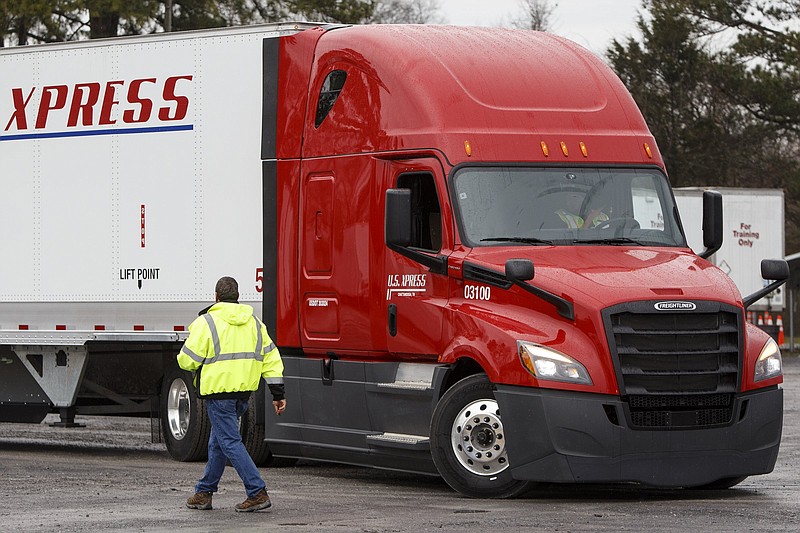Transportation industry officials have said for years there is a shortage of truck drivers.
The American Trucking Associations, a national trade association, issued a report last fall saying the industry would have to recruit nearly 1 million new drivers over the next decade in order to replace drivers that retire or leave the occupation.
About 1.9 million heavy truck and semitractor-trailer truck drivers are employed in the United States, according to the U.S. Bureau of Labor Statistics.
With ongoing supply chain and workforce issues across the country, the issue affects more than just trucking companies, Shannon Newton, president of the Arkansas Trucking Association, said in a statement in May.
"Our industry desperately needs more safe and qualified drivers to be able to stock grocery shelves and deliver all of life's essentials," said Newton.
However, research from the University of Arkansas' Walton College of Business seems to indicate there is no shortage. Instead, there are numerous reasons drivers continue to leave the profession for other jobs, often within competing industries, research shows.
"I don't think 'shortage' is the appropriate terminology," said Andrew Balthrop, a research associate at the college's Supply Chain Management Research Center.
Trucking companies don't pay high enough wages to attract or retain workers, Balthrop said. The industry generally doesn't raise wages fast enough to keep up with other competing industries, he added.
Arkansas has 32,560 drivers employed, the highest concentration of heavy truck and semitractor-trailer driver jobs of any state in the country, according to the U.S. Bureau of Labor Statistics.
Northwest Arkansas, home to J.B. Hunt and PAM Transport, alongside other companies like Walmart and Tyson Foods, has the second-highest concentration of those jobs among all metropolitan areas, employing 10,770 people, according to the bureau.
Joplin, Mo., home to Contract Freighters Inc., and the Fort Smith area, home to ArcBest and USA Truck, also have high concentrations of truck drivers, according to the bureau.
Representatives of PAM Transport and ArcBest said their companies have found ways to retain and attract drivers steadily in spite of industry reports.
Jason Turner, vice president of talent and growth initiatives at ArcBest, was hesitant to say the Fort Smith-based company has seen a shortage of drivers, though the pandemic has strained supply chain operations universally, he said. The integrated logistics company employs about 7,000 drivers and is always looking for more, he said.
"We've never not been hiring drivers," he said. "The war for talent, in general, has been rapid and evolving since 2020. Drivers have always been our top category of workers to hire."
ArcBest has held more than a dozen driver-focused hiring events this year in addition to accelerating efforts to recruit within veteran ranks, according to Turner. He said the company has also begun talking about the career to students.
"We're trying to get deeper in the school systems to tell the story of the career you can have as a driver," he said.
Turner said the leading cause of attrition for ArcBest drivers is retirement.
While most truck drivers are men, about 25% of drivers in ArcBest's Panther ground expedite fleet -- which involves driving cargo vans, sprinter vans, straight trucks as well as semitractor-trailers -- are women, he said.
Chelsea Wood, director of recruiting at PAM Transport, said the past year has been a record year for hiring drivers.
"We can tell it's hard to hire, but we've found ways to navigate through that," said Wood.
PAM Transport employs about 2,000 drivers, she said.
In February, the Tontitown-based company began offering commercial driver's license training at an on-site school as part of its CDL sponsorship program. As a part of the program, the company covers the estimated $5,000 cost of obtaining the license for new hires, she said.
The six-week program allows new drivers to meet future co-workers, be mentored by experienced professionals and make contacts within the company, which increases driver retention, she said.
PAM also aims to attract drivers by offering opportunities for career advancement as well as a lease-purchase program, where drivers get to own their trucks, she said.
She said she has noticed a lot of new drivers entering the field recently, and has not noticed migration away from the driving occupation to other jobs in the company.
Representatives of J.B. Hunt Transport Services Inc. in Lowell declined to comment on reports of a driver shortage or the company's recruitment efforts.
A July 2021 blog post on J.B. Hunt's corporate website cited the covid-19 pandemic, regulations requiring drug screenings of drivers and an aging workforce as three factors that affected the pool of available drivers.
In Northwest Arkansas, the annual mean wage for heavy truck and tractor-trailer drivers is $55,300, above the national average of $50,340, according to the U.S. Bureau of Labor Statistics. The annual mean wage for such jobs in the state as a whole is $49,090, according to the bureau.
Federal regulations limit drivers to about 60 hours of work a week and do not require time-and-a-half overtime pay for hours over 40, according to a report by the Bureau of Labor Statistics.
"Most tractor-trailer drivers work far in excess of 40 hours per week," the report states.
Other pressures can also put a strain on drivers, making recruiting and retention difficult for employers.
Truck drivers cited loneliness, loss of family life, health-related issues, lack of respect, government regulations and various work-related inefficiencies as factors which make the job particularly stressful, according to the white paper. Firms that address those factors will likely experience increased driver retention, the paper states.
